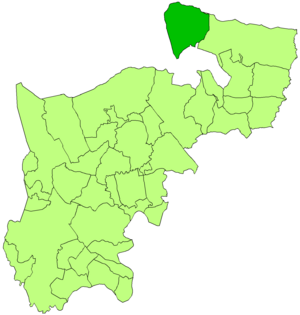Potters Bar Urban District facts for kids
| Potters Bar Urban District South Mimms Rural District (1894–1934) |
|
 Potters Bar within Hertfordshire in 1971 |
|
| Geography | |
| 1911 area | 6,105 acres (24.7 km2) |
| 1931 area | 6,129 acres (24.8 km2) |
| 1971 area | 6,129 acres (24.8 km2) |
| HQ | Barnet (1894–1932) Potters Bar (1932–1974) |
| History | |
| Created | 28 December 1894 (as South Mimms Rural District) 1 April 1934 (as Potters Bar Urban District) |
| Abolished | 31 March 1974 |
| Succeeded by | Hertsmere |
Quick facts for kids Demography |
|
|---|---|
| 1901 population | 2,671 |
| 1931 population | 5,720 |
| 1971 population | 23,950 |
| Politics | |
| Governance | South Mimms Rural District Council Potters Bar Urban District Council |
The Potters Bar Urban District was a local government area in England. It existed from 1894 to 1974. This district covered the town of Potters Bar and the village of South Mimms.
When it first started, it was called the South Mimms Rural District. This name changed in 1934 to Potters Bar Urban District. In 1965, the district moved from Middlesex county to Hertfordshire. It was eventually closed down in 1974 and became part of Hertsmere.
Contents
How Did South Mimms Rural District Start?
The South Mimms Rural District began from an older system. This system was called the Barnet Poor Law Union, created in 1835. These "unions" were groups that helped manage local areas. They also looked after public health in rural parts.
In 1894, a new law called the Local Government Act 1894 changed these areas. The rural parts became "rural districts." The Barnet area was split because it was in two different counties. The part in Middlesex became the South Mimms Rural District. The other part, in Hertfordshire, became the Barnet Rural District.
What Was the South Mimms Parish?
The South Mimms Rural District included only one local area, called a "parish." This was the parish of South Mimms. Because there was only one parish, the South Mimms Rural District Council did all the jobs that a separate parish council would normally do.
Before the new district started, the size of the South Mimms parish changed. Some parts were moved to other urban districts. For example, a part went to Barnet and another to East Barnet Valley. The parish of South Mimms got its new, smaller boundaries in December 1894.
The South Mimms parish and rural district had more boundary changes later on. These happened in 1896, 1924, and 1926.
When Did It Become Potters Bar?
On April 1, 1934, the South Mimms Rural District changed. It became an "urban district" and was renamed the Potters Bar Urban District. It covered the exact same area as before.
Later, in 1965, a big change happened for local government in London. Most of Middlesex county became part of Greater London. However, the Potters Bar Urban District did not join Greater London. Instead, it was moved to Hertfordshire county.
Where Were the Council Offices?
The South Mimms Rural District Council held its first meeting in January 1895. This meeting took place in Barnet, not in the district itself. They met at the Barnet Union Workhouse. For many years, the council continued to meet in Barnet. They used the workhouse or the office of their solicitor.
In 1932, the council finally moved its base to Potters Bar. They moved into a house called Tancreed on Darkes Lane. But they only stayed there for three years. In 1935, the council bought a nearby property called Osborne Nursery. They turned the house there into their main offices and meeting room.
The council quickly needed more space. In 1937, they bought two more buildings: Wyllyotts Manor and Oakmere House. The Osborne Nursery building remained the main office. But Wyllyotts Manor and Oakmere House were used for extra office space.
There were plans to build a new main building, called a civic centre. One plan was in 1939, but it was stopped because of the Second World War. Another plan in 1963 also did not happen.
How Was the District Abolished?
The Potters Bar Urban District was closed down in 1974. This happened because of a new law called the Local Government Act 1972. The district joined with other areas. These included the Elstree Rural District, Bushey Urban District, and part of the Watford Rural District. Together, they formed a new larger district called Hertsmere.
The new Hertsmere Borough Council decided to build its main offices in Borehamwood. Because of this, the old Potters Bar Urban District Council buildings were sold off. The former Osborne Nursery building was taken down. Two new houses were built on its site. Oakmere House and Wyllyotts Manor both became public houses.
Images for kids





